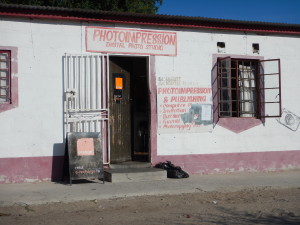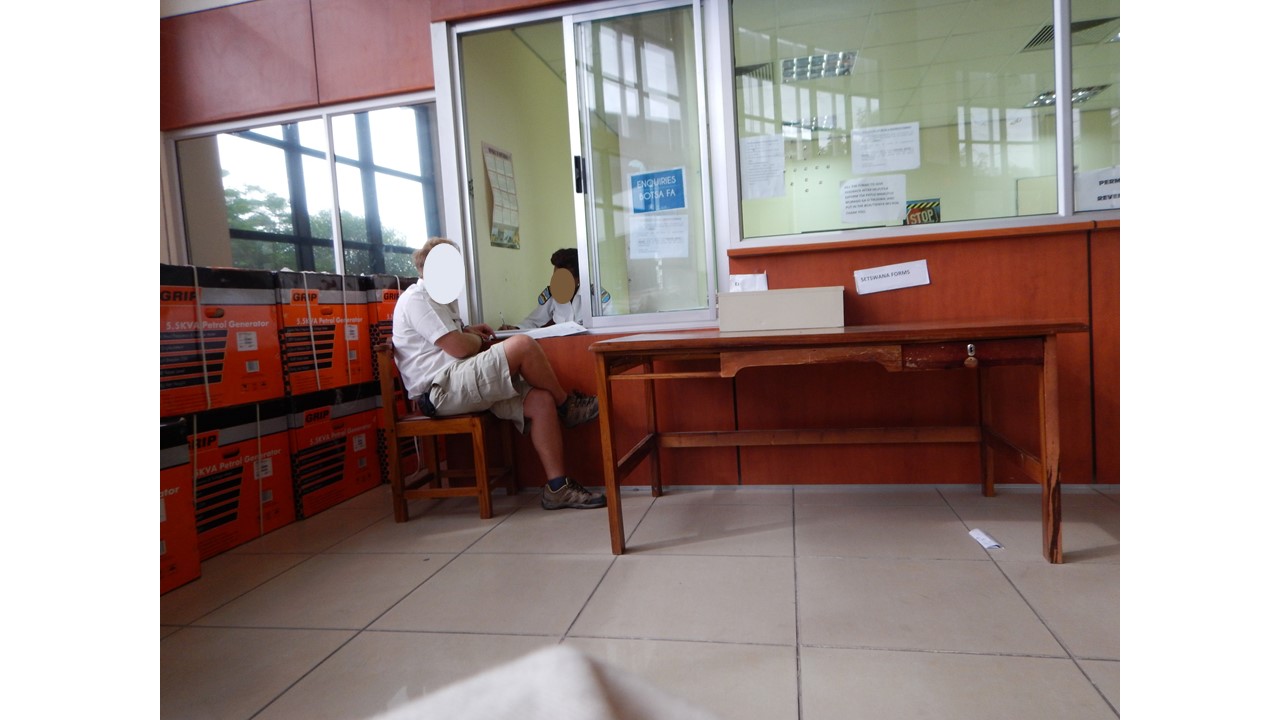Because my visit to Botswana exceeds 6 months, I need to apply for temporary residency. The very thought breeds images of lengthy lines in crowded waiting rooms.
Before I left the States, I called the Botswana Embassy in Washington D.C. to find out how to apply for residency. The lady who answered the phone had brief and not helpful answers to my questions. She mainly just repeated that I should look on the website, which I already had – and still didn’t understand what I needed to do. For a start, there is no mailing address for your application. Plus, you are supposed to send money – how much was unclear. The Embassy amount differed from that on the Government of Botswana website, which I had also searched. Moreover, does the money need to be cash? A check? A money order? And how will you know if it is received? The lady on the phone was insulted by my silly questions and eventually she hung up on me.
So much for the Botswana Embassy being helpful with immigration matters.
It caused me worry because I had also read on Botswana government websites that I needed to initiate the residency permit application BEFORE arriving in Botswana. That I should not wait until I arrived. But since I couldn’t figure out how to apply, I decided to go for a Visitor’s Visa upon arrival at the Maun airport and hope for the best. I also needed my Research Permit for my residency application and it arrived just three weeks before I left for Botswana.
When we arrived at the airport in Maun, the Immigration Officer gave me a 30-day Visitor’s Visa. I was too slow to ask for 90 days, which is also possible. So she gave my children 90 days, but having stamped my passport already, I was stuck with 30. It was important that I had my research permit upon entry to Botswana, but it is absolutely fine to apply for residency once I am here. Maun has an immigration office near Riley’s Garage, and if you go at 8 am, you are usually the first one in line. I am grateful to have a local immigration office. It would be a difficult, maybe impossible process to do successfully by mail.
So, now the meat of this blog post. What forms do you need to apply for residency, how much does it cost, and what the heck do they mean by “certified copy”? Incidentally, the process is the same, whether you apply for short term or long term residency.
If you are a Researcher, you need the following, available on a “checklist” from the Immigration Office. Note that I’ve used a checklist link from the Ministry of Labour & Home Affairs website. Some of the information in the weblink is already out of date (number of photographs needed and costs of various permits). The information I provide below is from a checklist I got last week (Jan 20, 2016) in person from the Maun Immigration Office.
- Form 15 (available here) is the main application form where you put your address, passport information, etc.
- Form 3 (available here) is a medical form that needs to be signed by your doctor. You should download this form just for amusement purposes. Locally, it is referred to as the “Idiot Form” – my American doctor found it fascinating. Most importantly, Form 3 must also be stamped by your doctor, a requirement that supposedly prevents forged Form 3s. I did not know this and failed to obtain any sort of stamp when my American doctor completed the form. Consequently I had to visit a doctor in Maun to get the form redone and stamped.
I went to see Dr. Luise Parsons who was recommended by the Okavango Research Institute, where I am based. Her ground floor office is Tsogo Family Care Medical Practice, located across the road from SPAR (this particular SPAR is located in the same mall as Orange and Nandos). Dr. Parsons was absolutely wonderful, was able to see me the same day I asked for an appointment, and also gave me a prescription for the malaria drug Coartem (just in case) (more on that in another post). Her stamp says “Dr. Luise Parsons, Tsogo Family Care Medical Practice, Maun”, and the date she stamped the form. Just for good measure, she stamped my form twice, but I think once is okay.
- A certified copy of the data page of your valid passport. This is the page with your picture on it. If you have a Botswana passport, you can get a certified copy from any police station – you bring your passport and the copy (they don’t have copy machines), and they stamp it to indicate that the copy is legitimate (sometimes they run out of ink for the stamp). I went to every police station in town and the Immigration Office at the Airport to get my passport copy certified (similar to notarized). Every place said, no, they do not certify foreign passports. It turns out that the downtown Immigration Office (different from the airport) will certify the copy for me when I submit my application. Good to know. If you needed to get a certified copy in the U.S., I think a notarized copy would work, particularly because the notary can provide that all important stamp.
- A copy of your birth certificate certified by the issuing office. I am treating this the same as my passport copy. I have the original and a copy, which will be certified by Immigration when I submit my application.
- Copy of marriage certificate certified by issuing office if accompanied by spouse.
- Three (yes, 3) recent, identical passport size photographs on a white background (no smiles please) – 30 x 40 mm. The checklist says to also include photographs of those in your company. I am not sure what this latter statement means. Separately I am applying for residency for my children, who require their own applications with photos (see below for the dependents checklist). So, I am only submitting pictures of me with my application. I asked Immigration today, and that seems to be fine..
Although I came to Botswana with extra passport photos, I only had two (naturally), so I had to get passport pictures taken in Maun. I got 4 photos made in about 3 minutes for 20 pula (US$2) by going to a photo store (see picture below) located in a small row of shops along the road behind the Orange/Nando’s Mall. Locally this mall is called the “Old Mall”. There is also a “New Mall”, and it’s possible I am mixing them up.

- Letter of support/sponsorship. For me, I have my award letter from Fulbright and a recent invitation letter from the Okavango Research Institute. The Invitation Letter is, as you are predicting by now, stamped with ORI’s official stamp (ORI, address, phone number, and date). The dates of my affiliation with ORI also match those on my research permit.
- Certified copy of the research permit from relevant authorities. I am handling this the same as the passport copy. I have the original and a copy, which will be certified by Immigration when I submit my application.
- 1500 pula (about US$150). I will take cash, in person, to the Immigration Office and have been assured that I will receive a receipt. If you were mailing your application, you can probably send a personal check or bank check. I don’t have a Botswana bank account yet, so I can’t do checks easily. Ironically, you need your residence permit to be allowed to open a bank account.
When you get you application together, make a copy and then get to the downtown Immigration Office at 8 am. I went today (my third try, each time I needed more forms or stamps or certified copies). The problem today is their network is down, as it was all last week. So I should come back “later” they said.
My 30-day Visitor’s Visa expires on Saturday. Not liking to wait until the last minute, I asked if they could give me a 60 day extension to the allowed maximum of 90 days. “Not today,” she said. I should “come back on Friday”. I guess I can’t be busy on Friday and I hope they don’t run out of ink. I sure will be happy when the paperwork is done and I can focus on research.
For my Children’s Residency Permit Applications, I need the following, available on a “Child of a Resident Checklist” from the Immigration Office.
- Form 15
- Form 3 (stamped)
- A certified copy of the data page of my child’s valid passport.
- A copy of my child’s birth certificate certified by the issuing office.
- Copy of adoption certificate certified by issuing office if the child is adopted.
- Three recent, identical passport size photographs on a white background (no smiles please) – 30 x 40 mm.
- Proof of enrollment from school if the child goes to school in Botswana (must be stamped by the school). My kids attend Matshwane Primary School and the Head Mistress is used to providing these letters, one per child, with the Matshwane stamp. It took her 5 minutes to prepare letters for me.
- Consent letter/affidavit from the child’s parents. This letter should be addressed to the Director of Immigration and Citizenship, Box 942, Gaborone, Botswana. It should include the requested dates of residency, and in my case, the dates need to match those on my research permit and my own application. The letter should state who the child will live with, a reason why residency is needed, and include a physical address and contact phone number for the child.
In Maun a physical address is different from a postal address. I know my physical address because it is printed on my lease. If I want mail sent to me, I have to obtain a post office box at the post office.
- Copies of parent’s work and residence permits certified by issuing office. Since I am not employed in Botswana, I only need a residence permit and a research permit, not a work permit. I plan to submit my children’s residency permit applications when I submit mine. I just need to wait for them to fix their network.
- 1500 pula (about US$150) per child.
